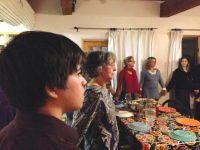
How does one go about locating a cohousing community that is a good personal fit? Here are my suggestions on how to go about finding a healthy, vibrant, and happy community.
For lots of background information, join and follow the national cohousing listserv (www.cohousing.org/cohousing-l) to read current conversations that are taking place. Watch videos about cohousing (www.cohousing.org/videos) and read the Best of Communities Cohousing Compilation (www.ic.org/community-bookstore/product/cohousing-compilation). Use a variety of ways to do your research (www.cohousing.org/node/1717) and follow Diana Leafe Christian’s tips for making the most of your cohousing visits (www.cohousing.org/node/1538). Go to meetings, eat meals, and interview people. Don’t be afraid to ask the hard questions, and don’t rely on what just a handful of people tell you.
If you really are adventuresome and willing to relocate, travel the country and visit a wide variety of communities, as did Keith Carlson (maryandkeith.blogspot.com) and Two Chicks and a Guppie (twochicksandaguppy.wordpress.com). Or find a housesitting or short-term rental opportunity (www.ic.org/short-term-vacation-cohousing-a-great-way-to-learn) in a community. Better yet, rent or share a rental with someone in a community for a longer period, as I did, before making a commitment.
What Will Your Questions Be?
Identify first your own high priority needs and values. Are you mostly looking for a sense of community? Or is sustainability an equal passion, with specific ideas you want to see implemented? Do you most value support for aging in place? Living with many generations, including children? Support for children and families? A high level of shared resources and activities? A farm or ecovillage with lots of land and gardens, or an urban, bicycle community? Intense focus on sustainability and climate change activism, or not so much? A spiritual focus and strong commitment to consensus, or more focus on efficiency with some hierarchy involved? A community with a lot of meetings and teams, or one with less to do and more fun? Shared meals that cater to your food preferences, or are you an omnivore?
Communal Life
Most folks are drawn to cohousing communities primarily for their social, collaborative, and communal cultures. Here are the questions you might ask:
● How do people get along at such close quarters and how well do they communicate?
● What is the community’s culture in regard to decision-making and conflicts?
● Generally, how do people treat each other?
● Are children’s and families’ needs addressed?
● Are people helpful and caring in times of crisis?
● Does the community use a traditional consensus model of decision-making and how successful is it?
● Has sociocracy (www.cohousing.org/node/2610) been considered?
● How much time is spent in meetings?
● Is the community in transition and why?
● How high is the participation rate in the ongoing work of maintaining the community?
● How well does the meals program function and how important is it to the community’s sense of family?
● How does the community handle “difficult” people who are not as skilled in expressing and resolving concerns in a positive, collaborative, compassionate, and solution-focused manner?
● Are renters treated as equal participants, including in decision-making?
My recent visits to three cohousing communities in Santa Fe confirmed my sense that communities do go through stages, and that strong meals programs, regularly used shared spaces, and a culture of respectful communication are three keys to creating a happy environment.
According to Ellen Kemper, one of the founding members at The Commons (santafecohousing.org) who seemed to have her finger on the pulse, her well-established community’s social fabric is strong. “We truly love and respect each other here—it runs deep.” The community has an active meals program and monthly work parties. Many have attended communication trainings and have actively worked to promote collaboration and peaceful conflict resolution.
At Sand River (www.sandriver.org), a seniors-only community, a consensus-based culture was established during formation by a spiritually inclined group of folks from Buddhist and Quaker backgrounds who already had experience with peaceful collaboration. “That really made a difference,” says Pam Gilchrist, one of the founding members.
Another community was in a period of transition. At the small community of Tres Placitas (tresplacitas.blogspot.com), founding members chose to save for rather than immediately build a common building for shared activities. Later the plan was modified and the building was never built. They have also struggled with the consensus model of decision-making. But communities do evolve. The current residents are working hard to increase their connections, with more shared meals in their homes and more focus on collaboration.
What about a community’s relationship to its neighbors and larger social environment? Here are more questions about external relations:
● If the community is or was a part of a larger-scale gentrification of the area, what is happening to support people and businesses of color in the area to prevent economic flight?
● What efforts did the community make at its inception to address racial diversity and affordability? What efforts are being made now?
● If the community is located in a low-income and racially diverse setting, does it welcome its neighbors and support “off campus” neighborhood events?
● Are there activists in the community who are working on social justice issues in the larger area?
Although Columbia Ecovillage, my community, appears to be primarily focused on sustainability, food production, and climate change issues, I’ve been pleased to see a fairly high degree of involvement in neighborhood issues. People don’t want to put up a gate. CEV members are active in various area efforts to clean up, show up, and support the community. But we have not made much progress on making our units more affordable or accessible to lower-income folks. People of color seem a long way off, except for the African American and Latino neighbors living in large apartment complexes all around our four-acre property! More could be done. This is probably true of many communities.
Sustainability
Cohousers are also drawn to cohousing because of its focus on sustainability. People want to live a smaller, simpler life with less impact on the environment. In my case, I was primarily drawn to one aspect of sustainability: gardening and farming and producing healthy food. What I didn’t know was that in this “ecovillage,” the largest source of conflicts appear to be related to land and plantings. I didn’t know that we had sustainability factions with hot disagreements between ornamental gardening, native plant, and permaculture factions. We disagree about planting and taking down trees, about moving plants, about maintaining the landscaping, about how we will continue to do the hard manual work as people age. And we have eco-activists like Marilee Dea (atu.com/news/local/City-Council-approves-anti-oil-train-resolution-considering-another) and permaculture advocates in our village who may be disappointed that most other members of the community are not so interested or engaged. Find out what exactly your prospective community is focused on in its efforts to be sustainable and decide if the type of focus is a good fit for you.
Take Responsibility!
There is no perfect cohousing community. As you interview residents, you will probably hear a wide range of opinions about how healthy or happy their community is. One resident will tell you there are lots of problems and conflicts. Another will tell you that the community is harmonious and that folks are content. A third may be moving out because cohousing didn’t fit them, and a fourth may tell you it’s the best thing they ever did.
Once you choose a community that seems the best bet, take responsibility to create an experience that is fulfilling, peaceful, and satisfying to you. In the final analysis, much of your satisfaction will depend on where you place your focus, with whom you spend time, and with which areas of the community’s work you want to be engaged. If you are actively involved in governance, you may experience significant conflicts and need to become skilled at compassionate assertiveness. If you contribute service hours only to activities you truly enjoy, such as gardening or cooking where policies are not being debated, you may be happy as a clam. If you hang out with folks who are unhappy, you may become more unhappy yourself. If you have trouble adjusting to the relative lack of privacy and autonomy in a community, you may rebel. And if you have fixed opinions about how things should be done, you may make yourself miserable.
I moved into my community in stages; first a three-month rental, then a 12-month rental, then finally a purchase. When I first moved in, I threw myself into multiple work groups and projects. I learned with time to better balance my community involvement with my life outside the community. I found I was not sufficiently motivated or skilled to participate in teams where I experienced a lot of conflict or domination by individuals. I became clearer about what aspects of community life I really enjoyed. I learned that governance leadership roles, after all, were not right for me. I also learned that I was most able to contribute to happiness and health through food production, cooking, and meals program support. It was up to me to create my own joy within a group of equally imperfect people and processes. My main aim was to be part of a “family,” to share, to grow spiritually, and to develop greater patience and serenity. I contribute to larger policy issues but try to do it in a respectful and constructive manner. My aims have been more than met. I hope yours will be as well.
Cynthia Dettman recently toured the Southwest in her camper van and visited four cohousing communities, delighting in their variety. For more details on cohousing in Salt Lake City, Utah and Santa Fe, New Mexico, check out her blog posts on cohousing at Voyage to the Present (voyagetothepresent.wordpress.com). Cynthia has been a member of her community’s conflict resolution team and is working on developing her NVC (nonviolent communication) skills. At Columbia Ecovillage (columbiaecovillage.org) in Portland, Oregon, she leads the meals team and tries to inspire cooks to prepare delicious and affordable food for meals and celebratory events.






















LScoho
Cynthia, this is great information! Thanks for breaking it up for people. I’d add reading cohousing books and sharing them with friends and family. Creating Cohousing: Building Sustainable Communities offers a lot of information on the cohousing structure, plus examples of successful cohousing communities. The book is a good bridge, especially if you don’t want to explain what cohousing is every single time you bump into friends.